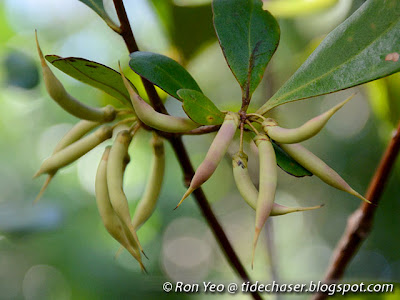This is certainly my favourite mangrove plant! The Kacang-kacang (Aegiceras corniculatum) is a nationally endangered mangrove tree from the family Myrsinaceae.
It is a true mangrove plant, and can hence survive partially submerged in brackish water during high tide. It is considered a minor mangrove species, and prefers sandy substrates, and normally occurs at the landward of mangrove forests or at the sides of mangrove rivers. The common name "Kacang-kacang" means "beans" in Malay.
This short tree has alternative/sub-opposite leaves arranged in a somewhat spiral manner. The leaves are rounded, and often appear wet, as they excrete salt through glands on the top side. As a result, they can sometimes be mistaken for the Api-api Ludat (Avicennia officinalis), which has similar features, but has opposite leaves instead.
The flowers form clusters, as shown in the young flower buds above.
The flowers are white with protruding anthers and a pinkish style. It exudes a sweet scent and has rich innectar.
Withered flowers reveal the pinkish styles, next to a cluster of flower buds on the right.
The young fruits appeared like a bunch of chillies.
The fruits ranges from green to pinkish to red in colour, and are strongly curved. This plant exhibits cryptovivipary, meaning that the embryo grows and breaks through the seed coat but not the fruit wall before it splits open.
The Kacang-kacang is a very useful plant - the bark contains saponin and is used to stun fish; the pretty and sweet-smelling flowers are used for ornamentation purposes and are also worn by local women; the wood is used for timber and charcoal production; and the young leaves are eaten by locals.
So far, I have only seen this plant on Pulau Ubin, Pulau Tekong, and in the mangrove forest next to Kranji Nature Trail. I understand that they were previously found at Mandai Mangrove also, but I had not seen it during my last few trips there. It was said to be present at Khatib Bongsu as well.
References
- Chong, K. Y., H. T. W. Tan & R. T. Corlett, 2009. A Checklist of the Total Vascular Plant Flora of Singapore: Native, Naturalised and Cultivated Species. Raffles Museum of Biodiversity Research, National University of Singapore. Singapore. 273 pp.
- Giesen, W., S. Wulffraat, M. Zieren & L. Scholten. 2006. Mangrove guidebook for Southeast Asia. RAP Publication 2006/07. FAO Regional Office for Asia and the Pacific & Wetlands International. Bangkok. 769 pp.
- Ng, P. K. L., and N. Sivasothi. 1999. A guide to the mangroves of Singapore 1 : the ecosystem & plant diversity. Singapore Science Centre. Singapore. 168 pp.

No comments:
Post a Comment